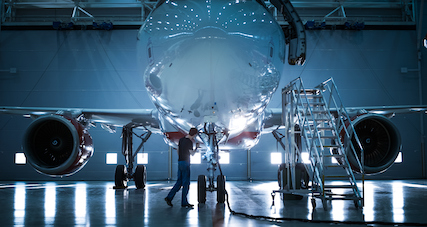Despite setbacks over the last few years, the commercial aviation sector has, in the minds of most analysts, shown that it’s likely to bounce back in the coming year as travel restrictions are lifted. During the last couple of years, increased defense spending has helped galvanize the aerospace industry as a whole. But it’s hardly the only factor at play. Today, both commercial and military aerospace sectors are poised to see increases in activity over the next 24 months — and with it, increases in production.
This growth will continue to strain an already exhausted global supply chain. So, we’re taking stock of the trends currently holding sway over the market during this time. While this is not intended to be a full list of factors impacting the global supply chain for the commercial and military aerospace sectors, these are a few trends to watch that could impact whether you get the components you need when you need them most.
AFTERMARKET AND MRO BECOME MORE IMPORTANT, EVEN AMONG OEMS
Recovery in air travel demand will likely drive an increase in aftermarket activity as higher aircraft utilization corresponds with increased maintenance, repair, and overhaul (MRO) work. This means that aircraft original equipment manufacturers (OEMs) are likely to expand their aftermarket service offerings to capture increased demand. In addition, pure-play MRO providers will likely collaborate and partner with smaller, regional competitors to grow their services business.
 Aftermarket, traditional MRO, and new MRO formats will begin to take centerstage in driving supply chain demands in the A&D sector
Aftermarket, traditional MRO, and new MRO formats will begin to take centerstage in driving supply chain demands in the A&D sector
COMPANIES BEGIN TO TURN AWAY FROM THE TRADITIONAL MRO
With the increase in maintenance, repair, and overall work, MRO providers will begin to move beyond conventional commercial aircraft repair services. For instance, expect more companies to expand into areas such as testing services for everything from electric aircraft to unmanned aircraft.
ADVANCED AIR MOBILITY (AAM) AND ALL-ELECTRIC AIRCRAFT BECOME MORE MAINSTREAM
Speaking of electric and unmanned aircraft, industry growth is largely being driven by Advanced Air Mobility (AAM) aircraft, which is gaining momentum and gradually becoming mainstream — especially as companies continue to receive substantial investment from sources ranging from traditional aerospace companies to private equity investors.
INVESTMENT IN MILITARY AIRCRAFT CONTINUES TO EXPAND
According to Deloitte’s 2022 Aerospace and Defense Industry Outlook, global defense spending is expected to grow about 2.5% this year as major world powers continue to strengthen their militaries in response to geopolitical tensions. The continued increase in global military spending will drive production demands for new aircraft.
SUSTAINABILITY INITIATIVES BECOME INCREASINGLY IMPORTANT
Sustainability planning will become more prominent as MROs formulate long-term strategies to increase efficiency and reduce waste. And as regulations get stricter, the production of new, more sustainable aircraft will grow as older and inefficient models cycle out of use.
PARTNERSHIPS IN THE GLOBAL SUPPLY CHAIN BEGIN TO EVOLVE
According to industry executives and analysts, global shipping and supply chain disruptions will continue to make it harder for manufacturers and suppliers to meet resurgent demand for parts. However, with long-standing supply chain challenges heightened by the global pandemic, a more collaborative approach will take shape between OEMs, MROs, and their supply chain partners.
 Innovative new formats that will drive demand and put additional strain on inventory levels will soon start to enter the A&D sector.
Innovative new formats that will drive demand and put additional strain on inventory levels will soon start to enter the A&D sector.
INCREASE IN COSTS AND RISK CONTINUES
Global supply chain disruptions are beginning to drive up costs and risk slowing down the aerospace industry’s recovery from the pandemic. This will put additional pressure on overall production decisions for OEMs and suppliers as the market starts to rebound.
ON-DEMAND INVENTORY WILL BECOME INCREASINGLY IMPORTANT
The rapid growth of the commercial aircraft market means there are much higher demands for mission-critical parts. OEMs that are building the next generation of aircraft will need connectors fast, but often can’t afford the risk of keeping large stocks of connectors in their own inventory. As a result, rapid delivery of quality connectors will shift from being an added bonus they look for in suppliers to a much more critical requirement going forward.
FIND OUT MORE
MORE INSIGHT ARTICLES

ADVANCED APPLICATIONS IN THE AVIATION INDUSTRY
The aerospace industry demands a higher degree of performance and world-class reliability due to extreme environments.

THE DIFFERENCE BETWEEN COMMERCIAL AND DEFENSE AEROSPACE
The A&D sector is one of the most high-profile markets. Here we look at differences between the two and trends impacting supply.

HOW TO SPECIFY A HERMETIC CONNECTOR
When it comes to hermetic connectors, you need the right partner who can help you identify the perfect connector for the job.
